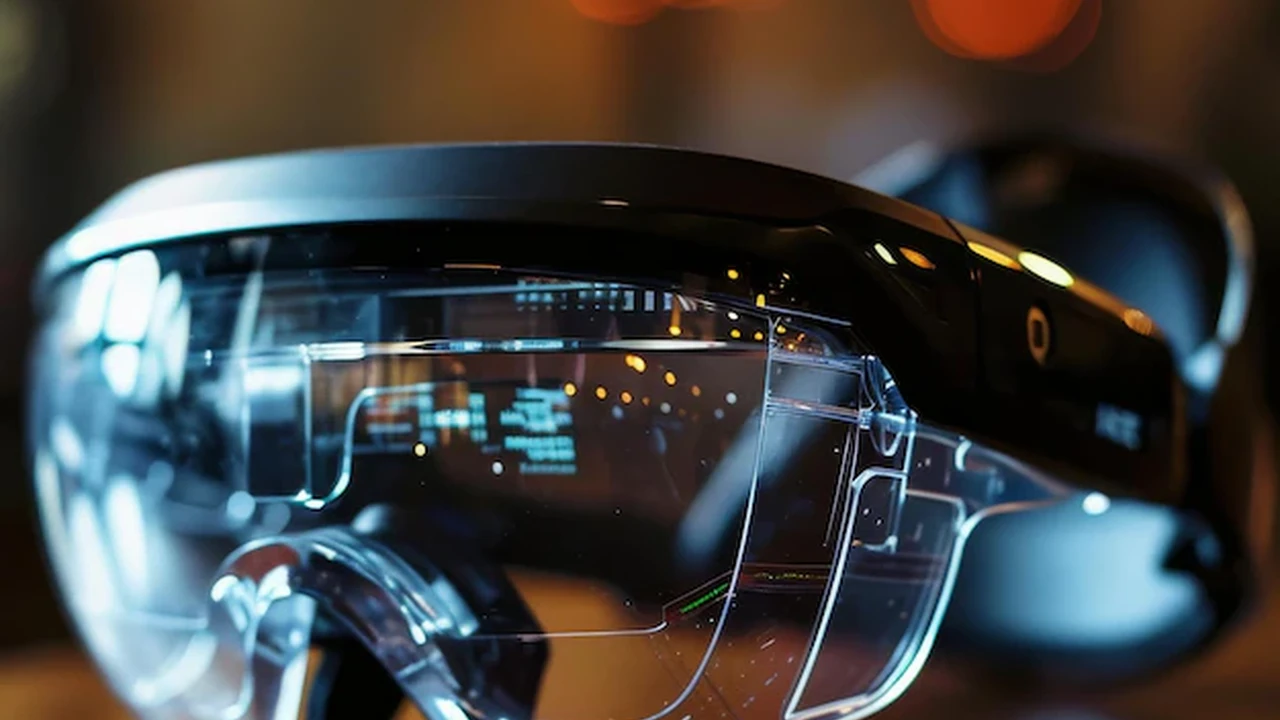
Best Smart Glasses for Augmented Reality Experiences
The Dawn of Augmented Reality Wearables
Welcome to the future, where your digital world seamlessly blends with your physical surroundings. Smart glasses, once a concept confined to science fiction, are rapidly evolving into a tangible reality, offering augmented reality (AR) experiences that promise to revolutionize how we interact with information, entertainment, and each other. Unlike virtual reality (VR) headsets that immerse you in entirely digital environments, AR smart glasses overlay digital content onto your real-world view, enhancing your perception and providing contextual information right before your eyes. This technology is not just for gamers or tech enthusiasts; it's poised to transform industries from healthcare and manufacturing to education and everyday communication. But with a burgeoning market, how do you choose the best smart glasses for your augmented reality experiences? This comprehensive guide will walk you through the key considerations, compare leading models, and help you find the perfect pair to step into the AR future.
Understanding Smart Glasses Key Features and Considerations
Before diving into specific products, it's crucial to understand what makes a pair of smart glasses stand out. The technology is complex, and various features contribute to the overall user experience. Here's what to look for:
Display Quality and Field of View for Immersive AR
The display is arguably the most critical component of any AR smart glasses. You want a clear, vibrant, and bright image that doesn't distract from your real-world view. Key metrics include resolution (how sharp the image is), brightness (how well it performs in different lighting conditions), and color accuracy. Equally important is the Field of View (FOV), which dictates how much of the digital content you can see at once. A wider FOV means a more immersive experience, as digital objects appear larger and more integrated into your surroundings. Some glasses use waveguide technology, while others might employ micro-LED or OLED displays. Consider how these technologies impact the visual fidelity and the overall sense of presence.
Comfort and Design for All Day Wear
Since smart glasses are worn on your face, comfort is paramount. Weight, balance, and fit are crucial, especially if you plan to wear them for extended periods. Look for lightweight designs, adjustable nose pads, and temple arms that can accommodate different head sizes. The aesthetic design also matters; some smart glasses aim for a discreet, everyday look, while others embrace a more futuristic or sporty appearance. Consider how the design integrates with your personal style and intended use.
Processing Power and Connectivity for Seamless Performance
The 'smart' in smart glasses comes from their internal processing power. This determines how smoothly AR applications run, how quickly digital content loads, and how responsive the user interface is. Look for devices with powerful processors, ample RAM, and sufficient storage for apps and data. Connectivity options are also vital. Most smart glasses rely on Wi-Fi and Bluetooth for internet access and pairing with other devices (like your smartphone). Some might offer cellular connectivity for standalone use. Consider the ecosystem they integrate with – Android, iOS, or a proprietary OS – as this will affect app availability and compatibility.
Battery Life and Charging Solutions for Extended Use
Like any portable electronic device, battery life is a significant concern. AR applications can be power-intensive, so a longer battery life means more uninterrupted use. Look for models that offer several hours of active use and consider their charging solutions. Some might use standard USB-C, while others could have proprietary charging docks or even swappable batteries for continuous operation.
Input Methods and User Interface for Intuitive Control
How you interact with your smart glasses is crucial for a good user experience. Common input methods include touchpads on the temple arms, voice commands, gesture controls (using hand movements), and sometimes even external controllers. A well-designed user interface (UI) should be intuitive and easy to navigate, allowing you to access information and control applications without fumbling. Consider which input method feels most natural and efficient for your intended use cases.
Audio Quality and Privacy for Communication and Immersion
Many smart glasses include integrated speakers or allow for connection to external headphones. Good audio quality is essential for calls, notifications, and immersive AR experiences. Consider whether the speakers are open-ear (allowing you to hear your surroundings) or provide more private audio. Microphone quality is also important for voice commands and calls. Privacy features, such as indicators when recording or taking photos, are also becoming increasingly important.
Top Smart Glasses for Augmented Reality Experiences Product Recommendations
Now, let's explore some of the leading smart glasses available today, catering to different needs and budgets. Please note that the AR smart glasses market is rapidly evolving, and prices can fluctuate.
Meta Ray-Ban Stories A Stylish Entry to AR
Overview: The Meta Ray-Ban Stories, a collaboration between Meta and Luxottica (Ray-Ban's parent company), are designed to look and feel like regular sunglasses, making them one of the most discreet smart glasses on the market. They focus on social sharing and casual AR experiences rather than full-blown immersive overlays. They are an excellent entry point for those curious about smart glasses without wanting a bulky, futuristic device.
Key Features:
- Integrated Cameras: Dual 5MP cameras allow you to capture photos and 30-second videos from a first-person perspective.
- Open-Ear Speakers: Discreet speakers in the temple arms provide audio for calls, music, and podcasts, while still allowing you to hear your surroundings.
- Microphones: Three microphones for clear voice capture and hands-free calls.
- Facebook View App: Companion app for managing content, settings, and sharing to social media.
- Touch Controls: Touch-sensitive areas on the temple arms for playback control and camera activation.
- Charging Case: Comes with a portable charging case that extends battery life.
Use Cases: Perfect for capturing candid moments, hands-free calls, listening to music on the go, and discreetly interacting with your digital world without pulling out your phone. Ideal for social media enthusiasts and casual users.
Pros: Stylish, discreet design; easy to use; good audio quality for open-ear speakers; seamless integration with Meta's ecosystem. Relatively affordable compared to other AR glasses.
Cons: Limited AR capabilities (no true visual overlays); privacy concerns due to discreet cameras; battery life could be better for heavy use; requires a Meta account.
Price: Starting around $299 USD.
XREAL Air 2 Pro Immersive Display for Media Consumption
Overview: The XREAL Air 2 Pro (formerly Nreal Air) are lightweight AR glasses primarily focused on providing a large, immersive virtual display for media consumption, gaming, and productivity. They connect to compatible smartphones, laptops, and gaming consoles, effectively turning any screen into a massive, portable display. While not full-fledged AR glasses with environmental mapping, they excel at delivering a personal cinema or workspace experience.
Key Features:
- Micro-OLED Displays: Deliver a sharp, vibrant 1080p image per eye, simulating a 330-inch screen from 20 feet away.
- Electrochromic Dimming: Allows users to adjust the transparency of the lenses, from fully transparent to a darker, more immersive mode for media.
- Lightweight Design: Weighing around 75g, they are comfortable for extended wear.
- USB-C Connectivity: Connects directly to compatible devices via USB-C, drawing power from the host device.
- Spatial Audio: Integrated speakers provide decent spatial audio, enhancing the immersive experience.
- Nebula OS (for Android): Provides an AR space for Android users, allowing multiple virtual screens and AR apps.
Use Cases: Watching movies and TV shows on a 'big screen' anywhere, mobile gaming, extending your laptop display for productivity on the go, and experiencing basic AR applications through the Nebula OS.
Pros: Excellent display quality and large virtual screen; lightweight and comfortable; versatile connectivity with various devices; electrochromic dimming is a great feature.
Cons: Requires a wired connection; limited true AR capabilities (no depth sensing or environmental mapping); not standalone; some compatibility issues with certain devices.
Price: Around $399 - $449 USD.
Vuzix Blade 2 Enterprise-Focused AR
Overview: The Vuzix Blade 2 is designed with enterprise and professional use cases in mind, offering a more robust and feature-rich AR experience compared to consumer-focused models. It's built for hands-free workflows, remote assistance, and data visualization in industrial settings, but can also be used by prosumers looking for advanced AR capabilities.
Key Features:
- Waveguide Optics: Projects a full-color display into your field of view, providing a clear overlay of digital information.
- Integrated Camera: An 8MP camera for capturing photos and videos, useful for remote assistance and documentation.
- Android OS: Runs on a customized Android operating system, allowing for app development and integration.
- Voice Control and Touchpad: Multiple input methods for hands-free operation.
- Wi-Fi and Bluetooth: Standard connectivity options for networking and peripheral pairing.
- Rugged Design: Built to withstand more demanding environments, often with safety certifications.
Use Cases: Remote expert assistance, hands-free instructions for assembly or repair, data visualization in logistics, inventory management, and training simulations. Also suitable for developers building AR applications.
Pros: Robust build quality; strong focus on enterprise features; open Android platform for development; good for hands-free operation in professional settings.
Cons: Higher price point; design is less consumer-friendly; battery life can vary depending on usage; not designed for immersive entertainment.
Price: Typically ranges from $1,299 to $1,999 USD, depending on configuration and accessories.
Magic Leap 2 Advanced Enterprise AR Platform
Overview: The Magic Leap 2 is a high-end, enterprise-grade AR headset designed for professional applications requiring precise spatial computing and advanced visual fidelity. It's not a pair of glasses in the traditional sense but a more substantial headset with a tethered compute pack, offering a truly immersive and interactive AR experience for complex tasks.
Key Features:
- Dynamic Dimming: Allows for variable transparency, enabling users to dim the real world to enhance the visibility of digital content, crucial for medical or industrial applications.
- Larger Field of View: Offers a significantly wider FOV compared to most smart glasses, making digital objects feel more integrated.
- Advanced Sensors: Equipped with multiple cameras and sensors for precise environmental understanding, hand tracking, and eye tracking.
- Tethered Compute Pack: A separate, powerful compute unit worn on the hip or shoulder provides the necessary processing power for complex AR applications.
- Open Platform: Supports various development tools and platforms, making it highly customizable for enterprise solutions.
Use Cases: Surgical planning and visualization, remote collaboration in engineering and design, advanced training simulations, and complex data visualization in industrial settings. Ideal for businesses and researchers pushing the boundaries of AR.
Pros: Industry-leading display quality and FOV; precise spatial tracking and interaction; dynamic dimming is a game-changer for professional use; powerful compute for demanding applications.
Cons: Very high price point; not a consumer device; tethered design can be less convenient; requires significant development effort for custom applications.
Price: Starting around $3,299 USD for the developer kit, with enterprise solutions costing significantly more.
Google Glass Enterprise Edition 2 Industrial AR Solution
Overview: Google Glass Enterprise Edition 2 is another strong contender in the industrial AR space, building on the legacy of the original Google Glass. It's designed to be a lightweight, hands-free device for frontline workers, providing contextual information and remote assistance capabilities directly in their line of sight. It's less about immersive AR and more about practical, heads-up display functionality.
Key Features:
- Optical Display: A small, discreet display in the upper right corner of the user's vision, providing information without obstructing the main view.
- Integrated Camera: An 8MP camera for capturing photos and videos, useful for remote expert calls and documentation.
- Qualcomm Snapdragon XR1 Processor: Optimized for AR and AI, providing efficient performance.
- Android Enterprise: Runs on Android, allowing for easy integration with existing enterprise systems and app development.
- Voice Commands and Touchpad: Multiple ways to interact with the device.
- Lightweight and Comfortable: Designed for extended wear in industrial environments.
Use Cases: Manufacturing assembly and quality control, logistics and warehousing (picking and packing), field service and maintenance, and remote training. Focuses on improving efficiency and reducing errors for frontline workers.
Pros: Very lightweight and comfortable for long shifts; robust enterprise support; easy to integrate into existing workflows; strong focus on practical, hands-free assistance.
Cons: Limited FOV compared to immersive AR headsets; not designed for consumer use or entertainment; higher price point for individuals; requires enterprise software integration.
Price: Typically around $999 USD, often sold through enterprise solution providers.
Choosing Your AR Smart Glasses The Right Fit for Your Needs
With such a diverse range of smart glasses available, selecting the 'best' one truly depends on your specific needs and budget. Here's a quick guide to help you decide:
For Casual Users and Social Sharing
If you're looking for a stylish, discreet way to capture photos and videos from a first-person perspective, listen to music, and take calls hands-free, the Meta Ray-Ban Stories are an excellent choice. They offer a subtle introduction to wearable tech without the bulk of traditional AR headsets. Their focus is on convenience and social connectivity, making them ideal for everyday wear and sharing your experiences.
For Media Consumption and Portable Displays
If your primary goal is to enjoy movies, play games, or extend your laptop screen on a massive virtual display, the XREAL Air 2 Pro stands out. Their micro-OLED displays deliver an impressive visual experience, effectively giving you a portable cinema or a multi-monitor setup wherever you go. They are perfect for travelers, commuters, or anyone who wants a large screen experience without a physical monitor.
For Enterprise and Professional Applications
For businesses and professionals requiring hands-free data access, remote assistance, or specialized AR applications, the Vuzix Blade 2 and Google Glass Enterprise Edition 2 are strong contenders. The Vuzix Blade 2 offers a more robust AR overlay for complex tasks, while Google Glass focuses on discreet information delivery and efficiency for frontline workers. Both are built for durability and integration into existing enterprise workflows.
For Advanced Research and High-End Development
If you're a developer, researcher, or enterprise looking to push the boundaries of spatial computing and require the most advanced AR capabilities, the Magic Leap 2 is the top-tier option. Its dynamic dimming, wide FOV, and precise tracking make it suitable for highly specialized and demanding applications, such as medical visualization or advanced engineering design. However, be prepared for a significant investment and the need for custom software development.
The Future is Clear The Evolution of Smart Glasses
The smart glasses market is still in its early stages, but it's evolving at an incredible pace. We're seeing continuous improvements in display technology, processing power, battery life, and form factor. As the technology matures, we can expect smart glasses to become even more integrated into our daily lives, offering seamless AR experiences that enhance productivity, entertainment, and communication in ways we can only begin to imagine. Whether you're an early adopter or waiting for the technology to become more mainstream, the journey of augmented reality through smart glasses is an exciting one to watch.
:max_bytes(150000):strip_icc()/277019-baked-pork-chops-with-cream-of-mushroom-soup-DDMFS-beauty-4x3-BG-7505-5762b731cf30447d9cbbbbbf387beafa.jpg)






